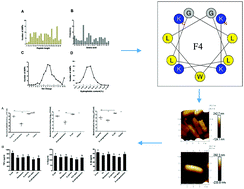Short, symmetric-helical peptides have narrow-spectrum activity with low resistance potential and high selectivity
Abstract
Broad-spectrum antibiotics have, until now, been the mainstay of antibiotic therapy. However, the increasing threat of drug-resistant bacteria and the ecological imbalance of normal microbial communities have forced a reconsideration of the best strategies to treat such pathogens. Therefore, antibacterial agents with specific abilities of eliminating pathogens may provide long-term protection. Antimicrobial peptides (AMPs), which can be optimized by modifying their primary sequences, are regarded as potentially valuable in development of pathogen-specific agents. To obtain efficient narrow-spectrum AMPs, database-filtering technology, which filters the most probable amino acid composition, positive charge, sequence length and hydrophobic content of peptides against Gram-negative bacteria, was taken as the first step. Then, the filtered parameters were distributed and modified into an α-helical symmetrical structure by considering the structure–function relationship of synthesized antimicrobial peptides. Finally, short, safe and stable peptides against Escherichia coli, Salmonella pullorum and Pseudomonas aeruginosa were successfully identified. The potential peptides F1 and F4 showed low cell toxicity, low resistance potential and low salt sensitivity. CD spectroscopy of the peptides illustrated that F1 and F4 exhibited a tendency towards an α-helical structure in a membrane-mimetic environment. Indeed, fluorescence spectroscopy and electron microscopy analyses indicated that the shorter potential sequence F4 killed the bacteria by causing physical destruction of the bacterial membrane and cytosol leakage. In the mouse model test, F4 reduced the bacterial load in major organs and the cytokine (TNF-α, IL-6, and IL-1β) levels in serum significantly (P < 0.05). Collectively, this symmetric-helical distribution, dependent on database-filtering parameters, is a promising strategy for designing effective smart AMPs with high cell selectivity, and it also provides new insights into the design and optimization of pathogen-specific biomaterials.



 Please wait while we load your content...
Please wait while we load your content...